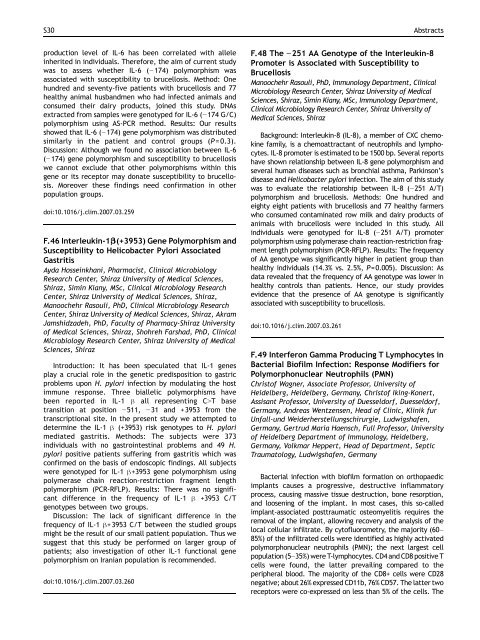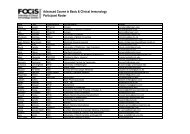Oral Presentations - Federation of Clinical Immunology Societies
Oral Presentations - Federation of Clinical Immunology Societies
Oral Presentations - Federation of Clinical Immunology Societies
Create successful ePaper yourself
Turn your PDF publications into a flip-book with our unique Google optimized e-Paper software.
S30 Abstracts<br />
production level <strong>of</strong> IL-6 has been correlated with allele<br />
inherited in individuals. Therefore, the aim <strong>of</strong> current study<br />
was to assess whether IL-6 (−174) polymorphism was<br />
associated with susceptibility to brucellosis. Method: One<br />
hundred and seventy-five patients with brucellosis and 77<br />
healthy animal husbandmen who had infected animals and<br />
consumed their dairy products, joined this study. DNAs<br />
extracted from samples were genotyped for IL-6 (−174 G/C)<br />
polymorphism using AS-PCR method. Results: Our results<br />
showed that IL-6 (−174) gene polymorphism was distributed<br />
similarly in the patient and control groups (P =0.3).<br />
Discussion: Although we found no association between IL-6<br />
(−174) gene polymorphism and susceptibility to brucellosis<br />
we cannot exclude that other polymorphisms within this<br />
gene or its receptor may donate susceptibility to brucellosis.<br />
Moreover these findings need confirmation in other<br />
population groups.<br />
doi:10.1016/j.clim.2007.03.259<br />
F.46 Interleukin-1β(+3953) Gene Polymorphism and<br />
Susceptibility to Helicobacter Pylori Associated<br />
Gastritis<br />
Ayda Hosseinkhani, Pharmacist, <strong>Clinical</strong> Microbiology<br />
Research Center, Shiraz University <strong>of</strong> Medical Sciences,<br />
Shiraz, Simin Kiany, MSc, <strong>Clinical</strong> Microbiology Research<br />
Center, Shiraz University <strong>of</strong> Medical Sciences, Shiraz,<br />
Manoochehr Rasouli, PhD, <strong>Clinical</strong> Microbiology Research<br />
Center, Shiraz University <strong>of</strong> Medical Sciences, Shiraz, Akram<br />
Jamshidzadeh, PhD, Faculty <strong>of</strong> Pharmacy-Shiraz University<br />
<strong>of</strong> Medical Sciences, Shiraz, Shohreh Farshad, PhD, <strong>Clinical</strong><br />
Microbiology Research Center, Shiraz University <strong>of</strong> Medical<br />
Sciences, Shiraz<br />
Introduction: It has been speculated that IL-1 genes<br />
play a crucial role in the genetic predisposition to gastric<br />
problems upon H. pylori infection by modulating the host<br />
immune response. Three biallelic polymorphisms have<br />
been reported in IL-1 β all representing CNT base<br />
transition at position −511, −31 and +3953 from the<br />
transcriptional site. In the present study we attempted to<br />
determine the IL-1 β (+3953) risk genotypes to H. pylori<br />
mediated gastritis. Methods: The subjects were 373<br />
individuals with no gastrointestinal problems and 49 H.<br />
pylori positive patients suffering from gastritis which was<br />
confirmed on the basis <strong>of</strong> endoscopic findings. All subjects<br />
were genotyped for IL-1 β+3953 gene polymorphism using<br />
polymerase chain reaction-restriction fragment length<br />
polymorphism (PCR-RFLP). Results: There was no significant<br />
difference in the frequency <strong>of</strong> IL-1 β +3953 C/T<br />
genotypes between two groups.<br />
Discussion: The lack <strong>of</strong> significant difference in the<br />
frequency <strong>of</strong> IL-1 β+3953 C/T between the studied groups<br />
might be the result <strong>of</strong> our small patient population. Thus we<br />
suggest that this study be performed on larger group <strong>of</strong><br />
patients; also investigation <strong>of</strong> other IL-1 functional gene<br />
polymorphism on Iranian population is recommended.<br />
doi:10.1016/j.clim.2007.03.260<br />
F.48 The −251 AA Genotype <strong>of</strong> the Interleukin-8<br />
Promoter is Associated with Susceptibility to<br />
Brucellosis<br />
Manoochehr Rasouli, PhD, <strong>Immunology</strong> Department, <strong>Clinical</strong><br />
Microbiology Research Center, Shiraz University <strong>of</strong> Medical<br />
Sciences, Shiraz, Simin Kiany, MSc, <strong>Immunology</strong> Department,<br />
<strong>Clinical</strong> Microbiology Research Center, Shiraz University <strong>of</strong><br />
Medical Sciences, Shiraz<br />
Background: Interleukin-8 (IL-8), a member <strong>of</strong> CXC chemokine<br />
family, is a chemoattractant <strong>of</strong> neutrophils and lymphocytes.<br />
IL-8 promoter is estimated to be 1500 bp. Several reports<br />
have shown relationship between IL-8 gene polymorphism and<br />
several human diseases such as bronchial asthma, Parkinson’s<br />
disease and Helicobacter pylori infection. The aim <strong>of</strong> this study<br />
was to evaluate the relationship between IL-8 (−251 A/T)<br />
polymorphism and brucellosis. Methods: One hundred and<br />
eighty eight patients with brucellosis and 77 healthy farmers<br />
who consumed contaminated row milk and dairy products <strong>of</strong><br />
animals with brucellosis were included in this study. All<br />
individuals were genotyped for IL-8 (−251 A/T) promoter<br />
polymorphism using polymerase chain reaction-restriction fragment<br />
length polymorphism (PCR-RFLP). Results: The frequency<br />
<strong>of</strong> AA genotype was significantly higher in patient group than<br />
healthy individuals (14.3% vs. 2.5%, P=0.005). Discussion: As<br />
data revealed that the frequency <strong>of</strong> AA genotype was lower in<br />
healthy controls than patients. Hence, our study provides<br />
evidence that the presence <strong>of</strong> AA genotype is significantly<br />
associated with susceptibility to brucellosis.<br />
doi:10.1016/j.clim.2007.03.261<br />
F.49 Interferon Gamma Producing T Lymphocytes in<br />
Bacterial Bi<strong>of</strong>ilm Infection: Response Modifiers for<br />
Polymorphonuclear Neutrophils (PMN)<br />
Christ<strong>of</strong> Wagner, Associate Pr<strong>of</strong>essor, University <strong>of</strong><br />
Heidelberg, Heidelberg, Germany, Christ<strong>of</strong> Iking-Konert,<br />
Assisant Pr<strong>of</strong>essor, University <strong>of</strong> Duesseldorf, Duesseldorf,<br />
Germany, Andreas Wentzensen, Head <strong>of</strong> Clinic, Klinik fur<br />
Unfall-und Weiderherstellungschirurgie, Ludwigshafen,<br />
Germany, Gertrud Maria Haensch, Full Pr<strong>of</strong>essor, University<br />
<strong>of</strong> Heidelberg Department <strong>of</strong> <strong>Immunology</strong>, Heidelberg,<br />
Germany, Volkmar Heppert, Head <strong>of</strong> Department, Septic<br />
Traumatology, Ludwigshafen, Germany<br />
Bacterial infection with bi<strong>of</strong>ilm formation on orthopaedic<br />
implants causes a progressive, destructive inflammatory<br />
process, causing massive tissue destruction, bone resorption,<br />
and loosening <strong>of</strong> the implant. In most cases, this so-called<br />
implant-associated posttraumatic osteomyelitis requires the<br />
removal <strong>of</strong> the implant, allowing recovery and analysis <strong>of</strong> the<br />
local cellular infiltrate. By cyt<strong>of</strong>luorometry, the majority (60–<br />
85%) <strong>of</strong> the infiltrated cells were identified as highly activated<br />
polymorphonuclear neutrophils (PMN); the next largest cell<br />
population (5–35%) were T-lymphocytes. CD4 and CD8 positive T<br />
cells were found, the latter prevailing compared to the<br />
peripheral blood. The majority <strong>of</strong> the CD8+ cells were CD28<br />
negative; about 26% expressed CD11b, 76% CD57. The latter two<br />
receptors were co-expressed on less than 5% <strong>of</strong> the cells. The




